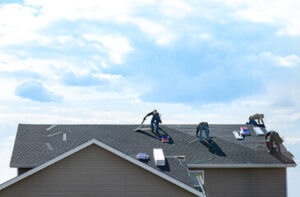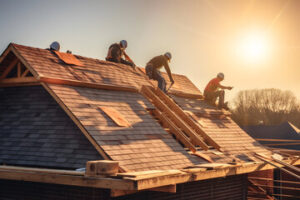Metal Roofing Helena offers a wide range of benefits for both residential and commercial properties. Its durability and design options make it an ideal choice for homes, barns, sheds and other agricultural structures.

Loose fasteners can lead to structural instability and put the building at risk of leaks, water damage, mold or mildew. Inadequate consideration for expansion and contraction can lead to loose or detached panels during strong winds or storms.
The longevity and durability of metal roofing is what often attracts people to it in a re-roofing or new construction scenario. This durability provides peace of mind in areas prone to hurricanes or other tropical storms and gives homeowners and commercial property owners the confidence that their roof is able to withstand even the harshest weather conditions. Additionally, steel roofs are incredibly resilient against heavy snowfall and hail. McElroy Metal offers over two dozen profiles in steel, each of which is rated with the class 4 process that tests resistance to hail and debris.
Additionally, metal roofs don’t succumb to the issues that can affect shingle roofs like mold, mildew, and rot. They’re also impervious to insects and termites, and are highly resistant to fire. Moreover, they can enhance energy efficiency by reflecting sunlight rather than absorbing it, and can lower cooling costs as well.
Although the durability of metal roofs is high, their lifespan is impacted by several factors. One of the most significant is the quality of the materials, as low-grade metals can rust in certain climates and be less durable during severe weather events. Additionally, the fasteners used to install metal roofs have varying lifespans. This can impact the performance of the entire system, as rusting or dislodging the fasteners can cause leaks and damage.
In addition to these considerations, a metal roof’s performance is also affected by the design of the entire system. It’s important to consider how the metal roof will connect to other building components, such as piping and venting. If these elements aren’t properly integrated, a potential chemical reaction can occur, which can compromise the durability of the metal roof.
Energy Efficiency
Metal roofs can reflect the sun’s UV rays, keeping homes cool in summer and warm in winter without the added cost of air conditioning. They also add an extra layer of insulation, further decreasing energy costs.
As a roofing material, metal is naturally fire-resistant and will not melt, allowing it to protect the structure of the home below from the effects of flames and embers. A metal roof is able to protect against many different types of weather, including extreme heat and cold, wind, rain and snow.
A metal roof will not rust or become damaged from the elements, and will continue to function for decades. However, as with any roof system, proper installation is key to ensuring that it will perform well. A professional roofing company with experience working with metal can help homeowners determine the best type of roof for their climate and aesthetic preferences, as well as ensure that their roof is properly installed to avoid leaks and other structural issues.
When choosing a color for your metal roof, keep in mind that lighter colors are more energy efficient than darker shades. As a result, they will be able to better reflect the sun’s UV rays and quickly revert back to their original temperature after sunlight stops hitting them. Darker shades, on the other hand, will absorb more of the sun’s heat and will take longer to cool down after sunshine has stopped striking them.
The beauty of modern metal roofing is that it can be finished in a wide variety of hues, ensuring that the right look can be achieved for any style or aesthetic. One example is a project that included both a metal roof and metal architectural walls, finished in Midnight Bronze to create a crisp, minimalist appearance that perfectly complements the surrounding building architecture.
Aesthetics
Modern metal roofing is a sleek aesthetic upgrade that adds to the aesthetic of residential and commercial buildings. Combining unparalleled durability with a vast array of style and color options, the roof revolutionizes the look of homes, elevating curb appeal for neighborhoods and property values.
The sleek appearance of metal roofs complements various architectural styles, ranging from the classic appeal of standing seam to the charming resemblance of shingle roofing. Metal roofing also fits into a range of roof shapes and slopes, including skylights, dormers, and valleys. Its versatility allows architects and builders to use the roof to create an attractive and functional design, adding to the overall value of a building.
A metal roof’s appearance is also affected by its finish. A gloss or matte finish can enhance the smooth and reflective surface of the roof, providing a sophisticated look that blends seamlessly into the home’s exterior. A textured finish, on the other hand, creates visual depth and texture, creating an eye-catching aesthetic that stands out from the rest of the house.
In addition, the wide array of color options for metal roofs allows homeowners to match or accent their home’s siding, trim, and surrounding landscape. The choice of color can also contribute to energy efficiency, as lighter colors reflect sunlight and reduce cooling costs in hot climates like Syracuse.
A metal roof’s aesthetic is further enhanced by its ability to seamlessly integrate with the structure. The panels typically interlock with hidden fasteners, eliminating the horizontal seams found in shingle roofs and the ridge vents that mask attic ventilation on shingle roofs. This seamless integration allows the metal roof to be viewed as part of the wall and roof assembly rather than separate structures, offering an aesthetic that is especially effective on contemporary designs.
Longevity
Metal roofs are renowned for their longevity, often outliving traditional asphalt shingle roofing by decades. This long lifespan results from their durability and low-maintenance requirements, a combination that makes them an attractive option for homeowners and commercial property owners alike.
Many factors contribute to a metal roof’s longevity, including the type of material used, installation quality, and environmental conditions. However, even the best metal roofs can suffer from weather-related issues that shorten their lifespan.
These include water damage, corrosion, dissimilar metal degradation (which occurs when two different types of metal are in contact with one another), and more. Preventative maintenance measures can help limit these problems and extend the lifespan of a metal roof.
Aside from repairing leaks and replacing damaged panels, a metal roof can benefit from regular cleaning and inspections. A thorough cleaning can remove dirt, debris, and grit that can cause scratches and other surface damage. A visual inspection can also reveal minor issues like loose fasteners or small dents that may lead to more serious issues in the future.
The pitch or slope of a metal roof can also affect its longevity, as steeper roofs shed water more effectively and reduce the risk of pooling. Additionally, choosing a roof coating that resists moisture, corrosion, and UV rays can further extend the life of a metal roof.
Homeowners can improve their metal roof’s longevity by implementing preventive maintenance measures and hiring professional roofing contractors for any repairs or replacements. A qualified roofer can assess a roof’s condition, recommend any necessary steps, and provide expert workmanship to ensure that the work is done correctly and lasts for as long as possible.
Maintenance
Despite metal’s ability to stand up to many types of weather, it still requires regular maintenance. Having a professional inspect the roof regularly is the best way to ensure it is in good condition and preventing problems like rust or water leaks.
In addition to checking for leaks, a professional roofer can look at the surface of the metal roofing to check for dents or scratches. These can occur due to the impact of a hailstorm or even an installation error, but can be repaired with touch-up paint matching the roof color.
A roofer can also examine the flashing around penetration points like chimneys, vents, and skylights. This is critical to prevent water infiltration, which can lead to rot and mildew in the interior of your home. A roofer can replace or repair the flashing if it is corroded, cracked, or missing.
Another important part of maintenance is cleaning the metal roof to remove dirt and debris. A professional roofer can use a power washer to clean the surface and prevent damage. They can also trim back any overhanging tree limbs that could hit the roof during storms or high winds.
Finally, a roofer can inspect the screw holes that hold down metal panels to see if they are loose or have backed out from expansion and contraction over time. This is especially critical for roof systems with exposed fasteners. A roofer can replace or tighten these to prevent leaks and further damage to the metal panels and the underlying structure of the roof. Metal panel seams should be checked for separation as well, which can lead to leaks and potential structural damage. A professional can caulk these joints to keep water from entering the home or business.
